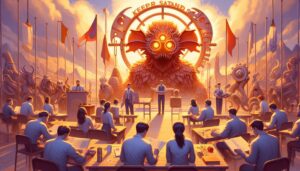Your Topics, Multiple Stories
5 min read
Your Topics, Multiple Stories allows you to go deep into a central theme and in an unexpected way. It uses multiple lenses to keep things...
This concept revolves around engaging readers by lacing together diverse narratives under a common theme. Instead of a single, linear story, this structure embraces variety, offering multiple angles on a central topic. It’s an effective way to cater to audiences with differing interests, all within the same universe.
Nowadays, where information is everywhere, it’s easy for readers to get lost in the noise, but what Your Topics, Multiple Stories does is lay out a buffet of stories. It hooks the reader by touching on their curiosity and keeping them invested.
Multiple Perspectives
In traditional storytelling, a singular voice or plotline often dominates the narrative, leading readers through a journey with a clear start and end. While that approach works for novels and long-form content, online readers—accustomed to shorter attention spans—require a format that keeps them engaged in bite-sized chunks. That’s where this concept of multiple stories comes in.
If you’re reading about climate change. You might come across a single article that talks about the facts, but after a while, it can feel overwhelming or even repetitive. Now, if the same topic is broken into different perspectives: an analysis of climate impact on coastal cities, a personal story of a farmer grappling with shifting weather patterns, and a tech feature on emerging green innovations. The experience becomes richer, more varied, and more relatable.
Your Topics, Multiple Stories allows you to go deep into a central theme and in an unexpected way. It uses multiple lenses to keep things fresh and exciting, making the subject feel more like a layered conversation than a monologue.
More Engaging, Less Monotone
Content creators and marketers alike are beginning to recognize the immense value of this approach. It’s not just about throwing different stories together haphazardly but rather curating them under an umbrella concept. In fact, the concept of multiple stories thrives when there’s a clear thematic connection.
Take health and wellness, for example. Rather than presenting an exhaustive piece on diet trends, Your Topics, Multiple Stories might feature four or five sub-stories. One story might discuss the science behind intermittent fasting, another could be a profile on someone who transformed their health through mindful eating, and a third could explore how different cultures view food and health. This provides texture and depth, making the reader feel more like an active participant in a dialogue than a passive recipient of information.
The end results in the audience staying interested for longer, feeling less fatigued, and ultimately leaving the piece with a broader understanding of the topic. They haven’t been subjected to one unrelenting viewpoint, but instead, they’ve been given a panoramic view of the subject.
The Spice of Storytelling
There’s a spice in this method that comes from its human-centric storytelling. Instead of bogging down the reader with technical waffle or statistics, multiple stories allow the inclusion of real people’s experiences, opinions, and emotions. It’s this personal touch that gives life to the information, adding richness and layers of relatability.
For instance, in tech journalism, many articles talk about innovations or industry shifts. However, by presenting multiple perspectives—such as interviews with innovators, stories of users adapting to new tech, and expert analyses—the topic feels more personal, interactive, and lively. This is a far cry from the static articles of yesteryears where readers could easily lose interest amidst mountains of facts.
The human element adds drama, conflict, and resolution—all the components of great storytelling—without ever feeling monotonous or heavy-handed. In doing so, the information feels alive, relevant, and engaging.
Real-Life Application in Marketing
Now, let’s take this concept out of the theory and apply it to marketing. Brands are increasingly utilizing multiple stories to convey a central message without sounding repetitive. Take a beauty brand’s launch of a new skincare product as an example. Instead of detailing product benefits, marketers now incorporate multiple angles: a story of a user’s transformation, behind-the-scenes content on how the product was made, a scientific breakdown of its active ingredients, and an expert dermatologist’s viewpoint on its efficacy
This type of narrative-driven marketing evokes emotions, builds trust, and builds a sense of community around the brand. Your Topics, Multiple Stories makes the audience feel involved in something larger than a singular advertisement.
Also visit this : Jd Vance Couch
The Importance of Curation
Not all multiple stories are created equal. For this approach to truly work, the stories must be thoughtfully curated. They must share a central theme but offer different layers and perspectives that complement each other without becoming repetitive.
Just like a well-crafted documentary series, Your Topics, Multiple Stories ensures the flow is seamless and logical. There’s a rhythm to the storytelling, allowing each piece to shine while maintaining a cohesive connection. Curating these stories requires skillful editorial vision and an understanding of the audience’s needs.
A Look Into the Future: Why This Approach Will Stick
The storytelling scenery is evolving, and the audience is changing with it. Gone are the days when readers had the patience. Today readers crave quick, engaging bursts of information. They want variety, and they want it fast.
Your Topics, Multiple Stories is set to be the future of online content. It mirrors the way we interact with information today—jumping from one interesting tidbit to another, gathering diverse viewpoints to form a complete understanding. It’s fast-paced but substantial. It’s concise but comprehensive.
Whether in marketing, journalism, or any other field of content creation, this method provides an excellent balance between depth and engagement, giving readers the best of both worlds. As we move further into the digital age, expect to see more content creators adopting this structure, as it aligns perfectly with the consumption habits of modern audiences.
Your Topics, Multiple Stories represents a shift in the way we consume information. It uses multiple narratives to build a more engaging and comprehensive story, providing readers with numerous entry points to the same subject. It’s the antidote to the overwhelming amount of content vying for our attention, offering a richer, more satisfying experience. With a future that promises even more information, this approach will help readers sift through the noise and find the stories that resonate with them.






